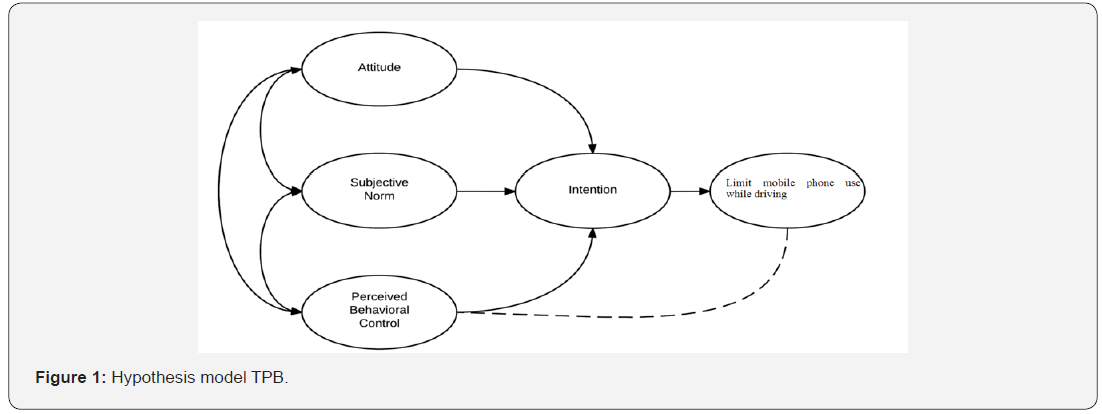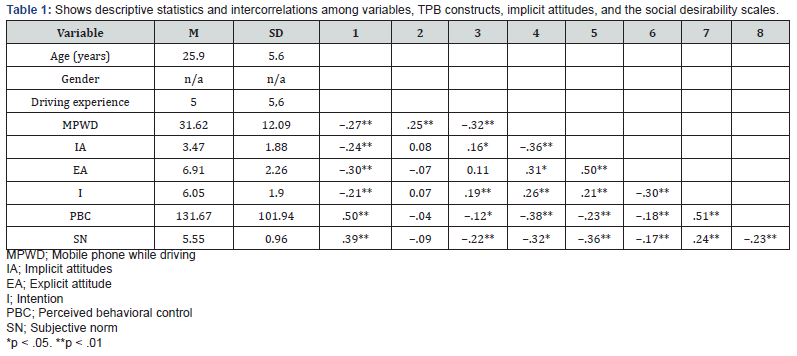Theory of Planned Behavior as a Model of Limit Mobile Phone use while Driving- Juniper Publishers
Civil Engineering Research Journal- Juniper Publishers
Abstract
Theory of Planned Behavior (TPB) is one of the most widely used psychological models when it comes to explaining road safety behaviors. Recently, studies have also been conducted from the perspective of dual-process models. However, the present is the first study on road safety behaviors that integrates both perspectives. The study evaluates the roles of both implicit attitudes and TPB constructs in the prediction of mobile phone use while driving. Method a sample of 100 drivers completed: (1) a self-reporting instrument on Mobile phone use while driving, (2) a questionnaire addressing TPB constructs, (3) an indirect measure of attitudes (Implicit Association Test), and (4) a social desirability scale. Results suggest that both types of attitudes make a significant and quite similar contribution to the explanation of Mobile phone use while driving. Interestingly, implicit attitudes were a better predictor than explicit attitudes among participants reporting inconsistent Mobile phone use Mobile Phone while driving. In addition, path analysis models suggested that implicit attitudes appear to be relatively independent of TPB constructs and have a direct effect on Mobile phone use. Conclusion the findings advance the idea of adding implicit attitudes to variables from the TPB model to increase the explanatory power of models used to predict road safety behaviors.
Keywords: Theory of Planned Behavior (TPB); Mobile Phone While Driving (MPWD); Road Safety Behavior (RSB).
Introduction
In our time mobile phones have been used to a large extent while driving, and taking into account that mobile network operators are constantly seeking to improve existing and to develop new services that drivers may find useful (web browsing, sending, receiving or reading text messages, etc.), overall time and exposure to the risk of mobile phone use while driving increases. Thus, for example, about 85% of American drivers [1], and two thirds of Finish drivers [2], use mobile phones while driving. Mobile phone use while driving has been recognized as one of the greatest challenges for road safety today, due to the increased risk of road crashes and the high prevalence of mobile phone use. Distraction is an important issue, as numerous studies in the cognitive psychology literature have shown that dual-tasking or multitasking has important and long-lasting perceptual and cognitive costs [3, 4]. In contrast we find that the relationship between attitudes and risk behaviors continues to be a relevant topic of research in various health areas [5]. A significant part of the research in this domain has been grounded in classic social psychology models [6]; in this respect, the theories of reasoned action (TRA) and planned behavior (TPB) have predominated [7]. In recent years the field has been revitalized thanks to theoretical developments on implicit attitudes [8, 9]. New questions, models, and methods have emerged from these developments. This article analyzes the role of implicit and explicit attitudes in road safety behaviors and is the first study in this field to integrate the contributions of both the more recent perspective on implicit attitudes and the classic TPB approach.
Mobile phone use while driving may be as dangerous as impaired driving, which is why this issue has become the subject of numerous studies that focused on the connection between mobile phone use and the risk of car crash occurrence, as well as on the examination of the influence mobile phone use has on driving performance. Given that ‘‘mobile phone use while driving”, has been recognized as a factor which has negative effect on driving performance and contributes to the occurrence of a car crash, large number of countries (Norway, Australia, etc.), have banned the use of hand-held mobile phones while driving. These countries have permitted the use of hands-free mobile phone while driving [10].
The use of applications designed to reduce mobile phone distractions while driving is a potential countermeasure that has gained public attention in recent years. These applications, considered voluntary as they can be activated and deactivated at any time, limit manual and attention consuming interactions with the mobile device while the vehicle is in motion [11]. The TPB is an additional theory which has been applied to assess acceptance in a road safety context. The TPB predicts that attitudes, subjective norms, and perceived behavioral control influence intentions, which in turn influence actual behavior [12]. In this case, attitudes refer to one’s favorable or unfavorable beliefs towards mobile phone applications, subjective norms refers to one’s perceptions that others (e.g., friends and family) would approve or disapprove of their use of mobile phone applications, and perceived behavioral control refers to the ease or difficulty of using mobile phone applications [12]. While previous research has applied the TPB to assess drivers’ intentions to use hand-held mobile phones while driving [13, 14], to date, and similar to the TAM, no research has applied this theory to assess acceptance of mobile phone applications.
The present study
In this study we analyze implicit and explicit attitudes toward a specific road safety behavior: mobile phone use while driving and to identify phases in the process of understanding mobile phone use while driving, as well as to draw certain conclusions with regard to the frequency of mobile phone use while driving, characteristics of persons who tend to use mobile phones more often while driving, impacts of using different modes of mobile phones on driving performance while driving (‘‘hands-free” or ‘‘hand-held”), and linkage between mobile phones use while driving and the risk of car crash occurrence. This paper aims to analyze the predictive ability of implicit and explicit attitudes in explaining mobile phone use while driving. For this purpose, (Figure 1), measures of both types of attitudes, as well as measures of the TPB constructs, were included (i.e., subjective norm, perceived behavioral control, and intention). The general hypothesis is that implicit attitudes will contribute to the prediction in limit to mobile phone use while driving even when considering the full TPB model. Based on the previous literature, a moderate to weak relationship between implicit and explicit attitudes is also expected. A secondary objective consists in determining the robustness of both explicit and implicit measures in terms of possible social desirability biases. In line with the previous literature [15], we expect explicit measures, but not their implicit counterparts, to correlate with social desirability

Materials and Methods
Participants
Sample drivers were selected from University of Setif2. Algeria, Total number of samples involved in this study was 200; (50 Females and 150 Males), the aged 20-35 years (mean = 25.9, SD = 5.6) took part in the study. The driving experience between 02 - 10 years (mean = 5 years, SD = 5.6).
Data analysis
Descriptive statistics and reliability estimates (Cronbach’s alpha) for all variables were obtained. The Implicit attitudes (IA) (Figure 2), consistency was estimated with a split-half analysis (D scores were obtained separately for even and odd trials and both scores were correlated). No data were missing. Correlations among variables were estimated with Pearson’s were used to assess the frequency of limit mobile phone use while driving in different conditions (as a driver in the city, as a driver on the highway, as a passenger in the city, as a passenger on the highway). Participants responded to the frequency of seatbelt use by using a five-point scale (“Never,” “Almost Never,” “Sometimes,” “Almost Always,” and “Always”). For some of the main data analysis procedures, these questions were added to obtain a single score of limit to mobile phone use while driving seatbelt use for each participant. This simplifies the statistical analysis; as well as provides a more reliable estimate of limit mobile phone use while driving. The internal consistency of this composite score was satisfactory, as indicated by a Cronbach’s alpha of 0.70.

Results
(Table 1) presents descriptive statistics for the variables. Note that the SN and PBC scales obtained lower internal consistency values, in part due to their low number of items. Attitude means suggest a positive global valuation of limit to mobile phone use while driving, both explicitly and implicitly. As previously mentioned, for the purposes of this study a composite score consisting of items from all conditions was computed. Cronbach’s alpha value (0.70) suggests this composite score has adequate internal consistency.

Discussion
1. This study was to analyze the role of implicit and explicit attitudes in seatbelt use: a specific road safety behavior, but one that also reflects a general safety orientation [16]. The most significant finding is that both types of attitudes contribute to the explanation of limit mobile phone use while driving. Furthermore, in the group of those with irregular of limit mobile phone use while driving, implicit attitude is a better predictor than explicit attitude, with the latter failing to show significant results in this sub-sample (Table 2). On the other hand, causal suggests implicit attitudes as relatively independent from the rest of the TPB constructs and affirms the idea of a direct effect on limit mobile phone use while driving. To sum up, our study suggests that implicit attitudes play an important role in road safety behaviors, contributing information on evaluative processes not considered in the TPB. These processes occur at a more automatic, less conscious level, but are equally capable of guiding safety behaviors. Finally, several studies examined the risks of mobile phone use while driving (‘‘hands-free” or ‘‘hand-held”). By summing up the results of such studies it can be concluded that the authors of mentioned studies have confirmed the connection between mobile phones use while driving and the relative risk of car crash occurrence. Namely, relative risk of a car crash is considerably higher for drivers who use a mobile phone while driving than for those who do not. Similarly, the authors of these studies have found that younger drivers are at higher risk of being involved in a crash.
For more about Juniper Publishers please click on: https://juniperpublishers.com/journals.php
For more Civil Engineering articles, please click on: Civil Engineering Research Journal
https://juniperpublishers.com/cerj/CERJ.MS.ID.555788.php


Comments
Post a Comment